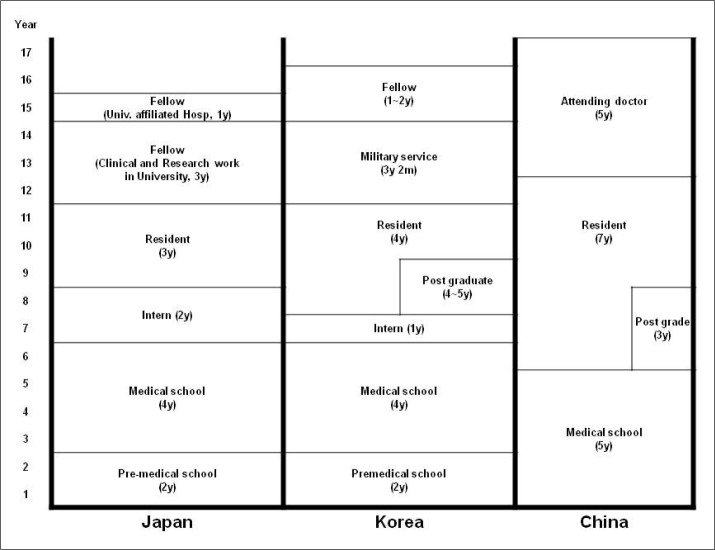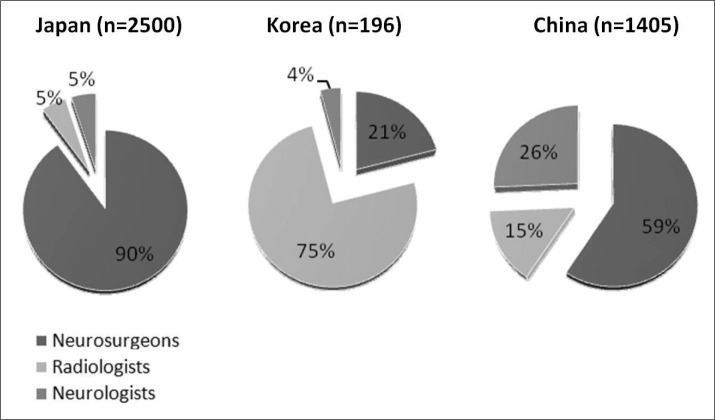Comparison of Medical Education and Requirements for Training in the Interventional Neuroradiology in China, Japan and Korea
- Affiliations
-
- 1Department of Radiology and Research Institute of Radiology, University of Ulsan, College of Medicine, Asan Medical Center, Korea. dcsuh@amc.seoul.kr
- 2Department of Radiology, First Affiliated Hospital of Nanjing Medical University, First Affiliated Hospital of Nanjing Medical University, China.
- 3Department of Neurosurgery, Nagoya University Graduate School of Medicine, Japan.
- KMID: 2052074
- DOI: http://doi.org/10.5469/neuroint.2013.8.1.3
Abstract
- The interventional neuroradiology (INR, or neurointerventional surgery) became a rapidly emerging specialty since the first Working group in Interventional Neuroradiology (WIN) meeting was held in Santa Barbara in 1980 by 15 pioneers. Although the specialty has been led by neuroradiologists, other specialists of neurosurgery and neurology have become involved. Due to diverse background of the specialties with inadequate requirement of education and training, proper level of training standard and quality assurance may be achieved for outcomes of treated patients with neurovascular diseases. In East Asia, there are less inter-relationship of education and training among China, Japan and Korea when compared to the learning opportunities in western countries from the three nations. Therefore, we present the current status and difference of medical education system and compare INR training to improve understanding of INR development in the adjacent countries.
MeSH Terms
Figure
Cited by 4 articles
-
International Survey on Criteria for Training and Accreditation in Interventional Neuroradiology
Yunsun Song, Minjae Kim, Michael Söderman, Dae Chul Suh, René van den Berg
Neurointervention. 2020;15(2):55-59. doi: 10.5469/neuroint.2019.00283.Current Status of Neurointerventional Activities in Korea
Yong-Moon Lee, Seon Moon Hwang, Eun Hye Kim, Dong-geun Lee, Jae Ho Shim, Dae Chul Suh
Neurointervention. 2013;8(2):65-67. doi: 10.5469/neuroint.2013.8.2.65.Recent Update of Guidelines for Neurointerventional Procedures
Shang Hun Shin, Soon Chan Kwon, Dae Chul Suh
Neurointervention. 2013;8(2):68-72. doi: 10.5469/neuroint.2013.8.2.68.Anesthetic Consideration for Neurointerventional Procedures
Kyung Woon Joung, Ku Hyun Yang, Won Jung Shin, Myung Hee Song, Kyungdon Ham, Seung Chul Jung, Deok Hee Lee, Dae Chul Suh
Neurointervention. 2014;9(2):72-77. doi: 10.5469/neuroint.2014.9.2.72.
Reference
-
1. Flodmark O, Grisold W, Richling B, Mudra H, Demuth R, Pierot L. Training of future interventional neuroradiologists: the European approach. Stroke. 2012; 43:2810–2813. PMID: 22910895.2. Picard L, Negoro M, Ter Brugge K, Mawad M, Lasjaunias P, Vinuela F, et al. 1998 world Federation of interventional and therapeutic neuroradiology. Guidelines for fellowship training programmes in interventional neuroradiology. Interv Neuroradiol. 1998; 4:195–197. PMID: 20673410.3. European Union for Medical Specialists. UEMS recommandations for acquiring "Particular Qualification" in endovascular interventional neuroradiology-INR. EJMINT. 2012; 1212000052.4. Accreditation Council for Graduate Medical Education. ACGME Program Requirements for Graduate Medical Education in Endovascular Surgical Neuroradiology. ACGME Approved Focused Revision: September 30, 2012; Effective: July 1, 2013.5. Spiotta AM, Sivapatham T, Hussain MS, Moskowitz SI, Rasmussen PA, Masaryk TJ, et al. Benefits of a multidisciplinary environment for neurointerventional training: fellows' perspectives. J Neurointerv Surg. 2012; 4:238–240. PMID: 21990528.
Article7. Kim KJ, Kee C. Reform of medical education in Korea. Med Teach. 2010; 32:113–117. PMID: 20163225.
Article8. Ren X, Yin J, Wang B, Roy Schwarz M. A descriptive analysis of medical education in China. Med Teach. 2008; 30:667–672. PMID: 18777425.
Article9. Taki W, Gotoh K, Hyodo A, Hyogo T, Kinugasa K, Koike T, et al. Editorial: the first specialist qualification examination of the Japanese Society of Intravascular Neurosurgery (JSIN). Interv Neuroradiol. 2002; 8:343–345. PMID: 20594495.
- Full Text Links
- Actions
-
Cited
- CITED
-
- Close
- Share
- Similar articles
-
- Perspectives on Fellowship Training Standard in Interventional Neuroradiology
- International Survey on Criteria for Training and Accreditation in Interventional Neuroradiology
- Interventional Radiology : Interventional Neuroradiology
- A Comparative Study on Medical Education Systems in Korea, China and Japan
- Anesthetic Consideration for Neurointerventional Procedures



